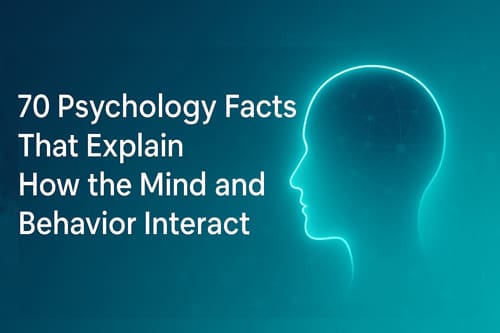70 Psychology Facts That Explain How the Mind and Behavior Interact

Introduction
A popular-science guide for healthcare professionals and curious readers. Human behavior arises from instincts, emotions, and learned responses. Though we often view our choices as rational, psychology shows that many are shaped by unconscious forces and hidden biases. The following 70 insights examine how thought, emotion, memory, and social connection shape who we are—each illustrating the interplay between the brain’s wiring and lived experience.
The Mind at Work
- Talking to yourself out loud enhances focus and problem-solving. It transforms thought into self-guided instruction.
- Messy handwriting often signals rapid thinking—ideas move faster than the pen.
- The brain detects negative words faster than positive ones, a remnant of our survival instinct to avoid danger.
- Multitasking reduces efficiency; shifting focus drains cognitive resources more than people realize.
- Doodling while listening improves memory retention by keeping the brain engaged just enough to prevent drifting.
- Mild fatigue increases creativity by loosening mental filters, allowing unusual ideas to surface.
- Thinking in a second language can make decisions more rational by reducing emotional interference.
- People who talk less often notice more; silence sharpens perception and empathy.
- Our brains are wired to prioritize threats over rewards, explaining why criticism often outweighs praise.
- The act of writing goals turns abstract ideas into tangible commitments, improving achievement rates.
Emotion and the Human Condition
- Social rejection activates the same pain circuits as physical injury, making emotional hurt biologically real.
- Laughter with a partner strengthens emotional bonds through endorphin release and shared perspective.
- A racing heartbeat can be misread as romantic attraction due to overlapping arousal signals.
- Facial expressions influence emotion—smiling can genuinely boost mood by activating happiness pathways.
- Empathy is rooted in mirror neurons, which allow us to feel others’ emotions as if they were our own.
- People who find humor in hardship tend to be more emotionally resilient and flexible.
- Those who forgive easily enjoy lower stress and healthier immune responses.
- Anger often conceals deeper emotions like fear or sadness, functioning as a psychological shield.
- People underestimate their attractiveness because self-perception magnifies flaws, while others see warmth and energy.
- Compassion physically calms the body by reducing cortisol and lowering heart rate.
Memory, Perception, and Belief
- Memory is reconstructive; each recall subtly rewrites the past.
- Emotionally charged events are remembered longer and more vividly than neutral ones.
- Writing down worries before bed clears mental clutter and improves sleep quality.
- People often create false memories, blending imagination and fact into believable stories.
- Visualization can strengthen skills by activating neural circuits similar to real practice.
- Reading fiction enhances empathy by letting readers experience other lives and emotions.
- Daydreaming fosters problem-solving and creativity by allowing the brain to explore possibilities without constraint.
- Your name grabs attention instantly—hearing it triggers alertness and emotional response.
- The color blue reduces anxiety and promotes calm by associating with safety and openness.
- We remember faces better than names because facial recognition evolved for survival.

Behavior in the Modern World
- Digital overstimulation reduces attention span, training the brain for novelty instead of depth.
- Phantom phone vibrations reflect anxiety and habitual checking behavior, not real signals.
- Smartphone loss triggers stress responses similar to separation anxiety.
- Silence makes people uneasy because it exposes inner thought; conversation often fills that void.
- Music with lyrics distracts focus more than instrumental tracks; the brain can’t process competing words easily.
- Those who stay calm in chaos often developed resilience through early stress exposure.
- People who walk quickly tend to live longer and exhibit higher baseline energy and optimism.
- Night owls often challenge authority and favor independent thinking.
- Loneliness weakens immunity and increases inflammation, proving social connection’s biological importance.
- Technology connects us globally but can dilute genuine empathy if overused.
Connection and Relationships
- People subconsciously mirror the body language of those they like, building unspoken rapport.
- Shared laughter between friends deepens trust and emotional connection.
- Opening up about personal experiences strengthens relationships through vulnerability and empathy.
- Small daily interactions with strangers—like a smile or greeting—boost happiness and belonging.
- Friendships formed in young adulthood tend to be the most enduring and meaningful.
- People with fewer but closer friends often report higher satisfaction than those with large social circles.
- Those who struggle with eye contact are often deeply introspective rather than disengaged.
- Most communication is nonverbal; tone and gesture carry more weight than words.
- Couples who show gratitude regularly report stronger, more stable relationships.
- Kindness toward others reflects inner peace more than external obligation.
Health, Resilience, and Well-Being
- Chronic stress disrupts digestion, immunity, and emotional stability.
- Adequate sleep enhances memory consolidation and emotional regulation.
- Morning light exposure improves mood and reduces risk of depression by aligning circadian rhythms.
- Physical activity releases endorphins, acting as a natural antidepressant.
- Helping others increases life satisfaction by reinforcing purpose and social value.
- Religious or spiritual practices often correlate with lower anxiety and improved resilience.
- A sense of control over one’s life predicts better mental health and longevity.
- Gratitude journaling improves overall well-being and sleep quality.
- People who live near water or green spaces experience reduced psychological distress.
- Lifelong learning and curiosity protect against cognitive decline and enhance life meaning.
Beyond the Ordinary Mind
- The human brain can rewire itself through imagination and focused attention.
- Morality is partly intuitive—people often feel a judgment before reasoning it out.
- Overthinking can be both a gift and a burden, amplifying creativity but also anxiety.
- Most decisions begin emotionally before logic rationalizes them.
- People who use sarcasm intelligently often score higher in creativity and social awareness.
- Our biases make us believe we’re less biased than others, a paradox of perception.
- Cognitive flexibility—the ability to adapt thinking—predicts success more than raw intelligence.
- Forgiveness and self-compassion lower stress and improve long-term health.
- Curiosity strengthens neural connections by encouraging learning and openness.
- Ultimately, the way we treat others mirrors our own internal state—kindness is self-revelation.

Conclusion 
Human behavior is endlessly intricate—a balance of biology, emotion, and learned experience. The more we uncover through psychology and neuroscience, the clearer it becomes that every reaction, habit, and feeling has roots in adaptation. By understanding these patterns, we gain not only insight into others but a clearer map of our own inner world.
Key References
- Damasio, A. R. Descartes’ Error: Emotion, Reason, and the Human Brain. Avon Books.
- Eisenberger, N. I., & Lieberman, M. D. Why rejection hurts: A common neural alarm system for physical and social pain. Trends in Cognitive Sciences.
- Loftus, E. F. Our changeable memories: Legal and practical implications. Nature Reviews Neuroscience.
- Kahneman, D. Thinking, Fast and Slow. Farrar, Straus and Giroux.
- Lyubomirsky, S. The How of Happiness. Penguin Press.
- Morin, A. Inner speech and consciousness. American Journal of Psychology.
- Cacioppo, J. T., et al. The neuroendocrinology of social isolation. Annual Review of Psychology.
- Rizzolatti, G., & Sinigaglia, C. The mirror mechanism: A basic principle of brain function. Nature Reviews Neuroscience.
- Pennebaker, J. W. Expressive writing: Connections to physical and mental health. Handbook of Health Psychology.
- Baumeister, R. F., et al. Bad is stronger than good. Review of General Psychology.

